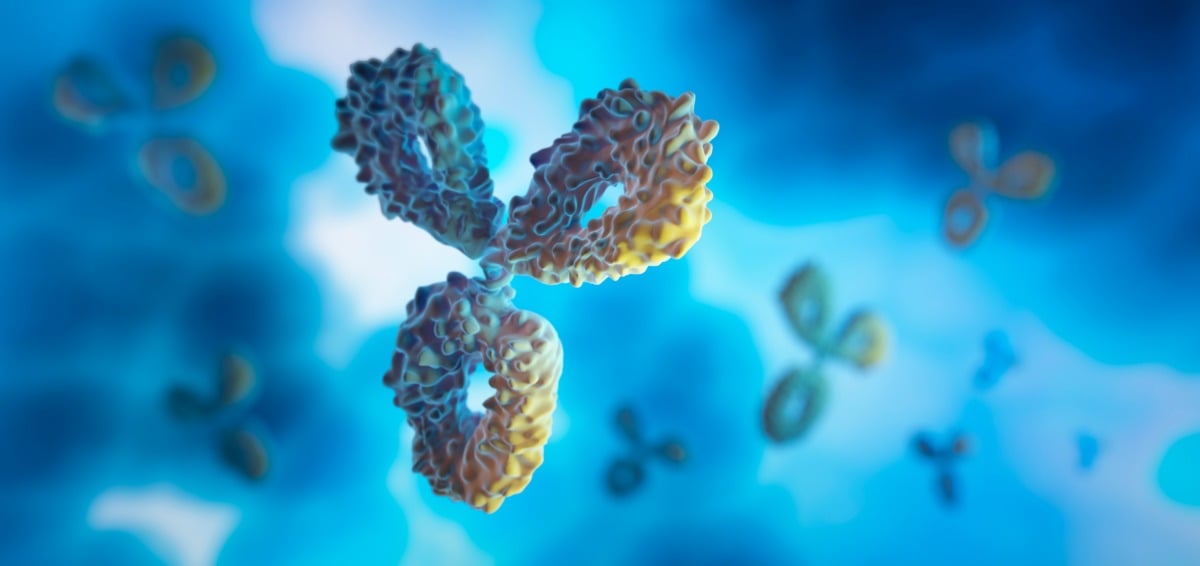Thanks to their unique features, bispecific antibodies are the fastest-evolving class of biotherapeutics. However, the enormous clinical potential of their unconventional design is accompanied by equally large challenges. How can we ensure reliable production and quality control of therapeutic bispecific antibodies?
Compared to monoclonal antibodies, bispecific antibodies (bsAbs) have two different binding areas that recognize two separate antigens or two epitopes on the same antigen. For example, one arm of the bsAb can bind to a tumor cell and the other to a tumor-killing immune cell, bringing them close together to increase the efficiency of cancer therapies.
Or, binding two epitopes on the same antigen can enhance the specificity of cell surface molecule recognition, increasing the potency of a therapeutic antibody and reducing side effects through nonspecific binding.
As of 2023, more than ten bispecific antibodies have been approved by the FDA, and more than 100 are currently in clinical trials, accounting for nearly 20% of the clinical antibody pipeline. However, the extraordinary features of bsAbs are associated with challenges in cell line development, production, and purification, jeopardizing the therapeutic success of bsAbs.
Heavy and light chain: It’s a match!
Bispecific antibodies are non-natural, often asymmetric molecules of various shapes and sizes. For their unique function, it is crucial that the corresponding heavy and light chains pair correctly, providing affinity for both antigens within a bsAb molecule. Therefore, developers seek to achieve a high percentage of correctly paired heterodimers – ideally close to 100%.
Classical techniques for correct heterodimer pairing include the production of monomers in separate cultures, followed by in vitro assembly. However, creating, maintaining, and controlling the quality of two cell lines increases cost and effort.
Novel molecular engineering techniques have been developed to force the heterodimer pairs together within a single cell, such as introducing opposite charges or affinities in the two Fc chains. The so-called knob-into-hole modification combines bulky amino acid residues on one Fc chain with small residues on the other to promote interaction.
In addition, the unconventional structures of bsAbs often interfere with correct protein folding and glycosylation, impacting bsAb quantity and quality. Generating stable cell lines that produce high yields of correctly folded, processed, and paired heterodimers is, therefore, the holy grail in bsAb development.
Monoclonal research cell banks for robust and qualitative expression
Swiss-based Selexis SA, a renowned global expert in cell line development, and KBI Biopharma, a global contract development and manufacturing organization, recently announced their operational consolidation under the KBI Biopharma name. Across its global network, and especially under one roof in Geneva, KBI Biopharma addresses the challenges of bsAbs.
The idea of providing a single cell line expressing bsAbs directly in the cell culture supernatant has been adopted by KBI Biopharma and relies on the SUREtechnology Platform™, powered by Selexis®. It employs the SURE CHO-M Cell Line™, a proprietary, optimized mammalian cell line, to generate high-performing clonal cell lines.

To isolate these research cell banks, KBI Biopharma has developed different cell line development workflows based on cutting-edge technologies. In one of these workflows, two automated colony-picking runs using ClonePix® 2 Mammalian Colony Picker devices are performed to statistically prove monoclonality as part of the regulatory requirements. Alternatively, a single run on an imaging-based single-cell cloning device (Beacon® Optofluidic System) is performed to isolate the final clones. Here, monoclonality is supported by imaging of single progenitor cells.
“Depending on our client’s needs for timelines, material supply, or early specific quality attribute assessment, our experts will suggest the best-adapted workflow for cell isolation and screening,” Séverine Fagète, PhD, VP Mammalian Cell Line Development, KBI Biopharma, said.
For challenging molecules such as bsAbs, the scientists can also select from a toolbox of dedicated solutions that support folding, processing, and secretion. Screening of the isolated monoclonal cell lines has been adapted to assess critical quality attributes early. “Our workflows have been specifically tailored to bsAb expression and we have introduced early checkpoints to not only screen for the titer but also for the purity of bsAb heterodimers” added Séverine.
Cell line development platform dedicated to empowering bsAb
As part of the KBI Biopharma’s SUREtechnology Platform™, powered by Selexis®, the experts apply molecular engineering to generate expression plasmids that tackle the most common bottlenecks, such as low expression, bioburden, competition with host cell proteins, aggregation, intracellular degradation, secretion, and genetic instability.
“The genes encoding for heavy and light chains are individually cloned into vectors with proprietary genetic elements that help recruit transfection factors to enhance expression levels and also promote stable integration into the host genome”, Séverine explained.

Built-in screening and quality control features
In a recent publication, Séverine and her team demonstrated their approach to maximize the yield of heterodimers and create a robust, high-quality production cell line. In this example, the bispecific antibody was designed with an asymmetric structure containing a scFv-Fc fusion chain of 50 kDa size and a heavy chain of 50 kDa with its corresponding light chain of 25 kDa.
A correctly paired heterodimer would have a molecular weight of 125 kDa, allowing selection by size analysis using dedicated technologies such as micropurification methods or microcapillary electrophoresis that enable analyzing minute sample amounts.
“These built-in quality assessment features are extremely useful in screening individual expressing clones and selecting the best one, as well as setting up quality control protocols. We have adapted our workflow to create assays that allow identifying the best-expressing cells at a very early stage,” Séverine explained.
Expression finetuning and super-transfection
In addition to molecular engineering and cell line optimization, heterodimer formation can be improved by finetuning expression levels of the individual subunits through optimized plasmid dosage.
“We also keep in mind that light chains can act as chaperones, promoting proper folding of the heavy chain subunits. In addition, some complex chains may have poor expression and therefore should be over-represented in the transfected vector molar ratio as a counterbalance”, Séverine added.
Novel techniques such as super-transfection – the reintroduction of expression plasmids to the primary cell clones – were demonstrated to further push toward heterodimer formation.
“Our strategic approach has been successfully applied to more than 25 bsAbs and has yielded up to 99% heterodimers with no main aggregation-related issues reported, greatly facilitating cell line generation and robust production of bispecific antibodies for clinical applications,” Séverine concluded.
Interested in learning more about KBI Biopharma’s strategic approach to bispecific antibodies?
Images courtesy: KBI Biopharma, Shutterstock






No Comments
Leave a comment Cancel